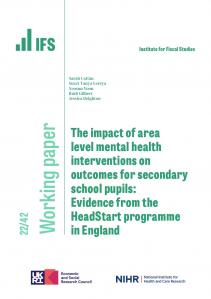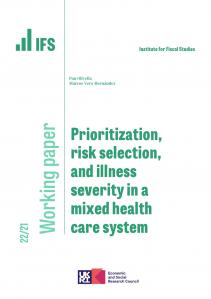Collection

After each Autumn Statement, Budget and Spending Review, we publish analysis of the Chancellor's proposals and reforms.
Chancellor George Osborne announced details of the 2015-16 Spending Round on 26 June 2013.
On Thursday 27 June, the day after the Spending Round, the Institute for Fiscal Studies held a lunchtime briefing at The Building Centre, Store Street, London. The presentation provided an opportunity to hear a considered view of the Chancellor's announcements from Institute staff.
Presentations from the briefing can be downloaded from the following links:
- Paul Johnson: Spending review 2013: opening remarks
- Gemma Tetlow: "We shall squeeze... until the pips squeak"
- Jonathan Cribb: Public sector pay and employment
- Luke Sibieta: School funding reform
- Carl Emmerson: Controlling Annually Managed Expenditure
On Friday 7 June the IFS and the Institute for Government (IfG) hosted a background briefing for members of the press. This event took place at the IfG. The presentation and publication accompanying the briefing are below.
- Carl Emmerson's briefing presentation
- The IfG Briefing Note accompanying the event
The slides delivered at a briefing by IFS staff the day after the 2013 Budget are below.
- Paul Johnson Introductory remarks
- Gemma Tetlow Fixing the budget to fit the figures?
- Rowena Crawford Spending review 2013 and beyond
- Stuart Adam Budget measures
The IFS Green Budget 2013, funded by the Nuffield Foundation, was published on 6th February. The document and slides from the launch are available here. In particular, the analysis includes chapters looking at:
- In an IFS observation 'Cutting the deficit: three years down, five to go?', Gemma Tetlow examines the progress of the government's fiscal consolidation plan.
- In a Public Finance Magazine article, Biting the bullet on fiscal targets, Carl Emmerson and Gemma Tetlow discussed the Chancellor's fiscal rules and the merits of abandoning his supplementary debt target.
- In The Fiscal Challenge Ahead, IFS researchers outline the significant challenges we face as a result of the spending pressures created by population ageing and a likely loss of tax revenues from motoring and north sea oil and gas companies.
- Rowena Crawford and Paul Johnson examine what is happening to the composition of public spending in The rapidly changing state, an IFS observation.
- In an IFS observation, researchers examine the Chancellor’s previously stated intention to reduce welfare expenditure by a further £10 billion per year by 2016–17 and explore where the cuts might be made.
- IFS researchers produced a Briefing Note, examining the changing composition of public spending. They find that the shape of the state today is very different from that of 30 years ago and that spending on health, pensions and long term care is set to take up a far greater share of public expenditure unless there is significant reform, or unless total spending is significantly increased.
- A briefing note on Pensioners and the tax and benefit system, examines the ways in which the proposals produced by the Dilnot Commission on the Funding of Care and Support could be funded.
- A report on NHS and social care funding: the outlook to 2021/22 examines what can be expected once the current period of broadly flat NHS funding in real terms ends in 2014-15.
- IFS researchers have compiled a list of tax and benefit changes in each Budget since 1979.
- In two recent observations, IFS researchers examine The Effects of the Welfare Benefits Up-rating Bill and review the key features of the new 'High Income Child Benefit charge'.
- We examine the pensions White Paper detailing plans to replace the current Basic State Pension and State Second Pension with a single state pension in an IFS observation.
- Here we discuss the merits of two policies: the reintroduction of a 10% income tax rate on a narrow band of income and a ‘mansion tax’ on residential properties worth more than £2 million.
- In a Fiscal Studies journal article, researchers analyse the likely effects of introducing a new Universal Credit.
- In a report, Fairer by design: efficient tax reform for those on low to middle incomes, Paul Johnson draws on the Mirrlees Review of taxation to identify key reforms that could help to ease the squeeze on living standards by making the UK tax and benefit systems both more efficient and fair.
- In Tax by Design, the Mirrlees Review editorial team present a picture of coherent tax reform. Its aim is to identify the characteristics of a good tax system, to assess the extent to which the UK tax system conforms to these ideals, and to recommend how it might realistically be reformed in that direction.
- In “Really, we’re in it together”, Paul Johnson looks at the extent to which falling household incomes have been equally spread across the income distribution.
- In Poverty and Inequality in the UK: 2012, IFS researchers assess the changes to average incomes, inequality and poverty, with a particular focus on the changes that have occurred in the latest year of data (2010-11).
- In an IFS observation Measuring and addressing child poverty, IFS researchers take the opportunity to reflect upon what child poverty is and how it should be measured, and to discuss current government thinking in this policy area.
- A chapter from the Green Budget 2013, Tax and welfare reforms planned for 2013-14, gives an overview of the tax and welfare reforms currently planned for the coming financial year and their likely impact on household incomes.
- An IFS Commentary, Child and working-age poverty from 2010 to 2020, presents forecasts of relative and absolute income poverty in the UK among children and working-age adults for each year between 2010-11 and 2015-16, and for 2020-21.
Collection details
- Publisher
- IFS
More from IFS
Understand this issue

Should we worry about government debt?
11 April 2024

Public investment: what you need to know
25 April 2024

The £600 billion problem awaiting the next government
25 April 2024
Policy analysis

Recent trends in and the outlook for health-related benefits
19 April 2024

4.2 million working-age people now claiming health-related benefits, could rise by 30% by the end of the decade
19 April 2024

Oil and gas make Scotland’s underlying public finances particularly volatile and uncertain
27 March 2024
Academic research

Do work search requirements work? Evidence from a UK reform targeting single parents
1 February 2023

The impact of area level mental health interventions on outcomes for secondary school pupils: Evidence from the HeadStart programme in England
13 October 2022

Prioritization, risk selection, and illness severity in a mixed health care system
16 June 2022